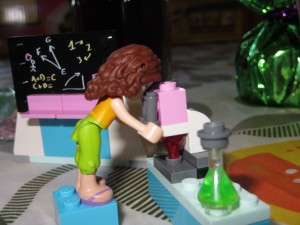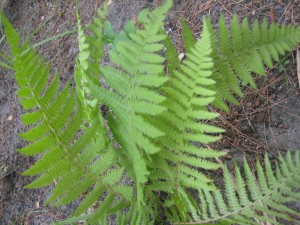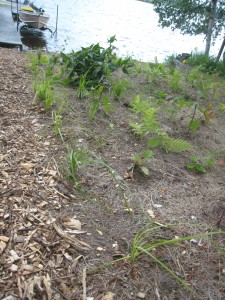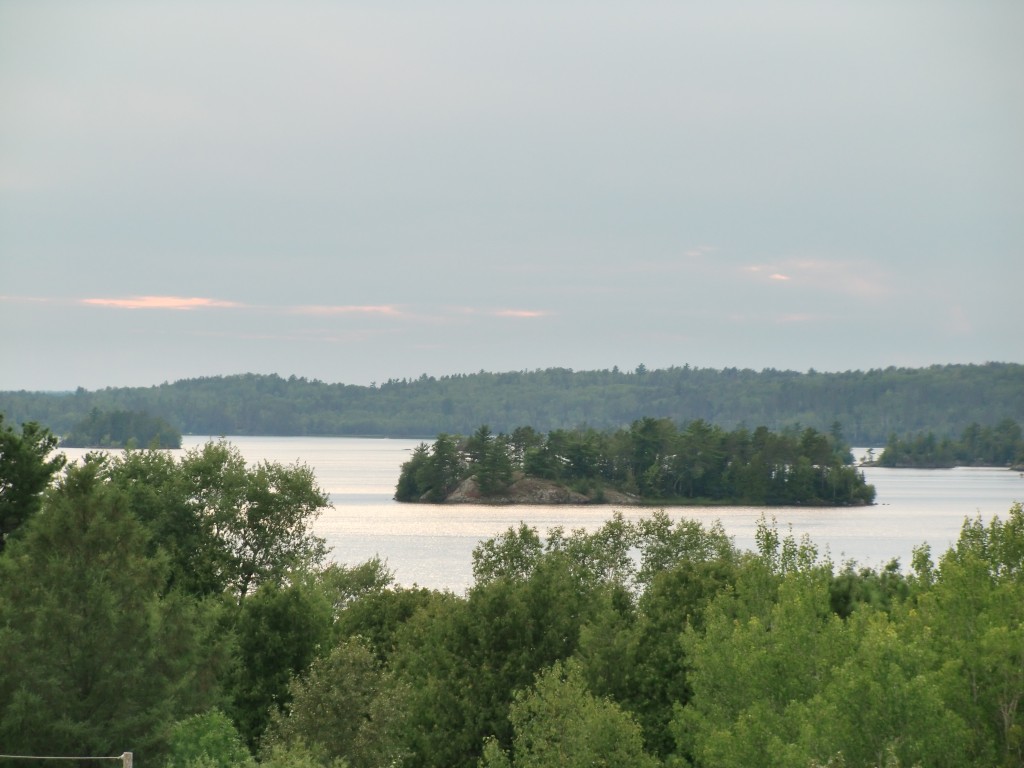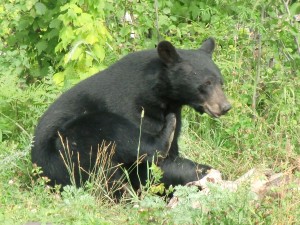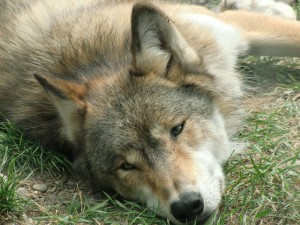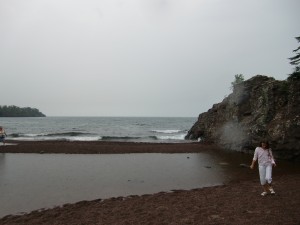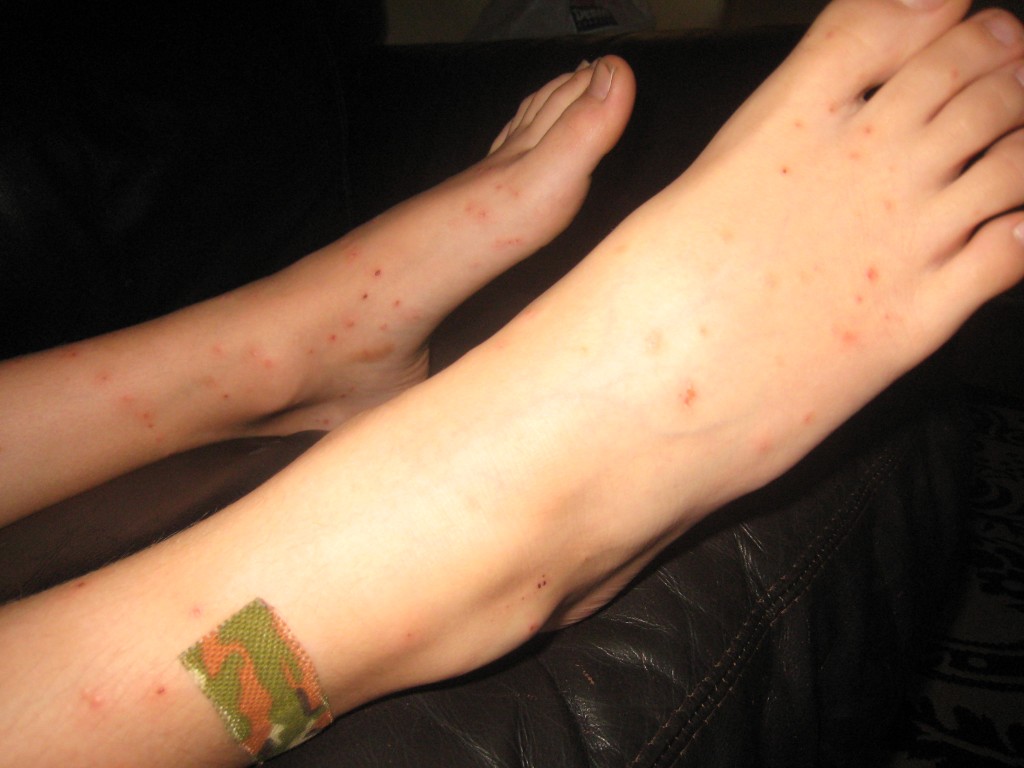Tag: minnesota’
Ice Science: Lifting an Ice Cube Using Salt and a String
- by KitchenPantryScientist
Have you ever wondered why putting chemicals like salt on a road makes the ice melt?
To see how NaCl (table salt) melts ice by lowers the melting temperature of water, you’ll need an ice cube, a glass of water, and a piece of kitchen twine or string about 6 inches long and salt.
What to do:
Drop an ice cube in a glass of ice water. Try to pick the ice cube up without your fingers by simply placing the string on it and pulling up. Impossible, right?
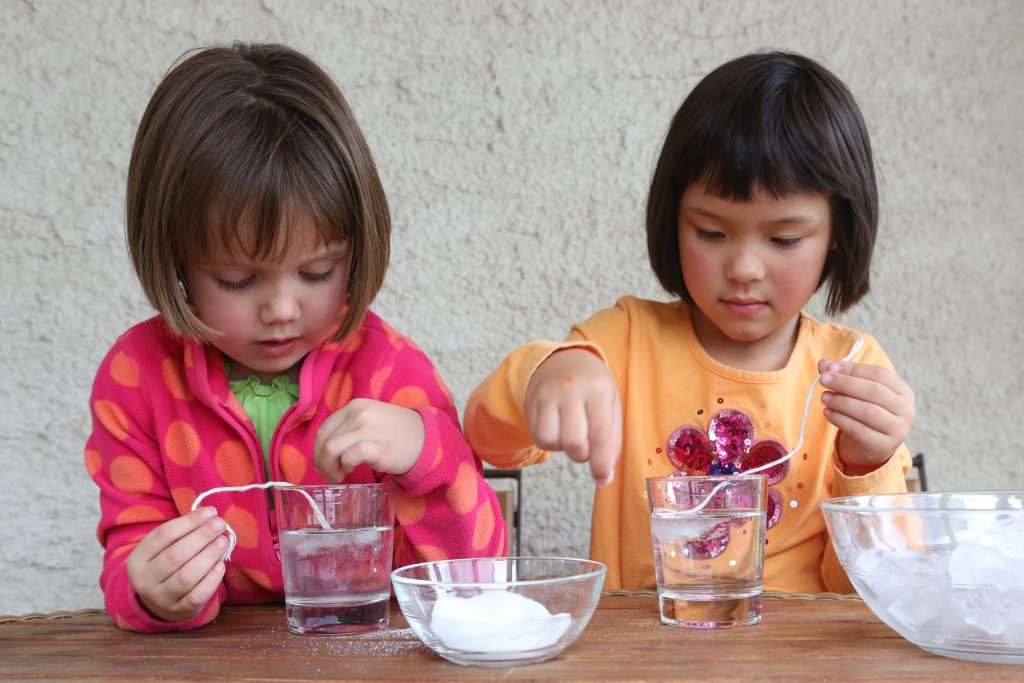
From Kitchen Science Lab for Kids (Quarry Books 2014)
Now, dip the string in water, lay it across the ice cube and sprinkle a generous amount of salt over the string/ice cube. Wait about a minute and try again to lift the cube using only the string. What happens?
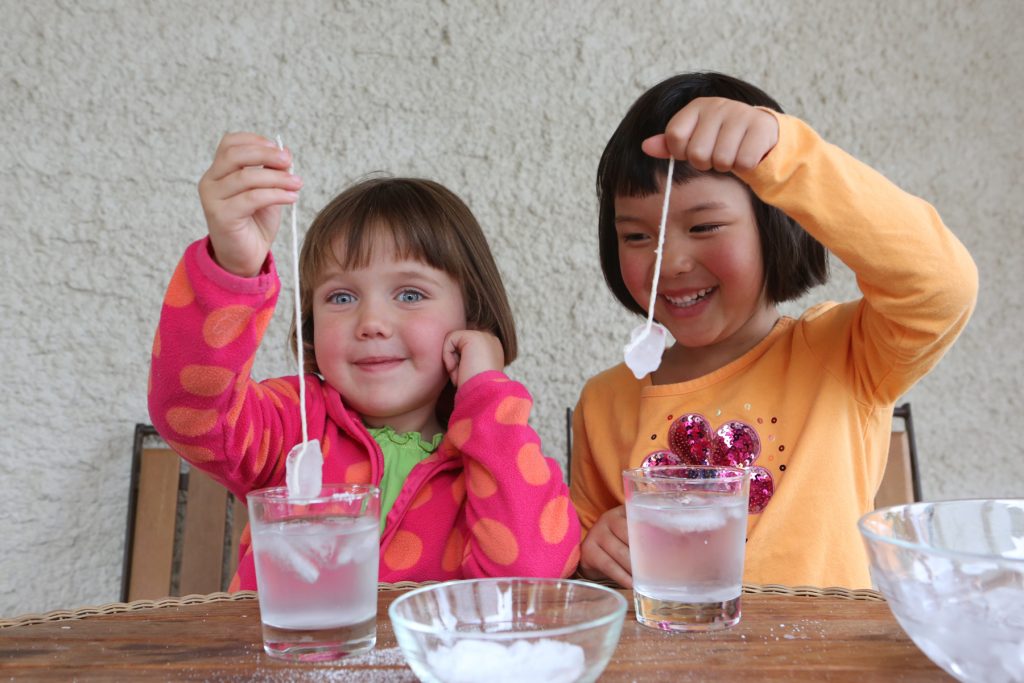
From Kitchen Science Lab for Kids (Quarry Books 2014)
It may seem like magic, but it’s only science. Watch me demonstrate the experiment by clicking here.
Salt lowers the temperature at which ice can melt and water can freeze. Usually, ice melts and water freezes at 32 degrees Farenheit, but if you add salt to it, ice will melt at a lower (colder) temperature.
The salt helps the ice surrounding the string start to melt, and it takes heat from the surrounding water, which then re-freezes around the string.
Different chemicals change the freezing point of water differently. Salt can thaw ice at 15 degrees F, but at 0 degrees F, it won’t do anything. Other de-icing chemicals they add to roads can work at much colder temperatures (down to 20 degrees below zero.) If it’s cold enough, even chemicals won’t melt the ice.
Brrr.
Pressure can also make ice melt at colder temperatures. This is why ice skates glide on rinks. The pressure is constantly melting the ice a where the blade presses down on it so the blade glides on a thin layer of water!
#SpaceMicrobes
- by KitchenPantryScientist
A soil bacterium we swabbed last spring on the set of Twin Cities’ Kare11 News is headed to the International Space Station! Even though we collected it here in Minnesota, Streptomyces kanamyceticus (we’ll call it S.kan for short) was first isolated from dirt in Japan.
It’s a very cool bacterium. Not only does it grow in really interesting colonies like the ones you see in the photo below, but it produces an antibiotic called Kanamycin that’s widely use in research, industry and medicine. Our #MinnesotaMicrobe takes off on March 16th from Kennedy Space Center on a SpaceX-3 rocket! Follow the mission on Project MERCURRI’s website, here on my blog, or using the #spacemicrobes hashtag on Twitter.

After we sent our sample off in the mail, it was swabbed onto bacterial growth medium and these cool little colonies were grown by the scientists from Project MERCURRI, alongside other samples swabbed from NFL and NBA stadiums, NASA spacecraft, and even from a candy jar at Kare11’s sister NBC studio at the Today Show. Around 40 of the samples were chosen to travel to the International Space Station (ISS) for a “Superbowl” of microbes. Scientists want to study how the bacteria grow and change in space and want to get the public excited about the project.
Why should we care how bacteria grow on the ISS, or on any spacecraft?
Microbes behave oddly out in space, and when humans exit Earth’s atmosphere, we carry microscopic inhabitants along with us. Tiny terrestrials (mostly bacteria) outnumber our bodies’ own cells by about ten to one, and microbes too small to see with the naked eye cover everything you around you, assuming you don’t live in a sterile bubble.
Pseudomonas aeruginosa, a funny little bacterium that smells like grapes and loves water, grows differently in microgravity. These bacteria form slime layers called biofilms and can cause problems for extraterrestrial toilets and water systems, like the ones on the International Space Station (ISS). Here on Earth, P. aeruginosa can make people who have been badly burned and people with cystic fibrosis (CF) really sick.
NASA also discovered that spending time on the International Space Station made Salmonella bacteria, which cause food poisoning, more virulent. In other words, they can make you sicker.
By studying what happens to terrestrial bacteria in space, scientists can discover new ways to fight infectious disease on Earth and hope to prevent mechanical and medical disasters on future space missions. Microbes may even offer ways to clean up waste in space or generate new medications mid-mission. After all, it will take a long time to get to Mars, and it may be a one-way trip for the first humans to travel there!
If you want to make your own microbial growth plates at home to see what’s growing around your house, you can find directions and a video on how to do it here. In the next week or so, I’ll post instructions for a cool new microbiology experiment that I’ve been thinking about.
What is Influenza and how does your flu shot protect you?
- by KitchenPantryScientist
As I wrote this post, Minnesota went from orange to red on the Center for Disease Control’s FluView map. Click here to see how active viral influenza is in your area.
This season’s manifestation of the flu (H3N2) is currently burning it’s way though the Twin Cities, sending droves of tough Minnesotans coughing and shivering to their beds. Five people have already died from the flu, two of them teenagers. Stomach bugs, caused by other viruses, are making their rounds too, but when health care workers and scientists talk about flu, they’re talking about viral influenza.
How can a shot help prevent a horrible case of the flu and why do you need a new one every year? Can you avoid the flu by washing your hands?
It helps to understand a little bit about the influenza virus. Like I tell my nursing students: know your enemy and you’ll have a better chance of outsmarting it!
Viruses are tiny packages of genetic material (DNA or RNA) that can infect every type of life on Earth, from bacteria to humans. They’re not considered living, because they can’t make new copies of themselves outside their host organism. In fact, to replicate themselves, they have to hijack their host’s cellular machinery. Essentially, viruses are extremely tiny parasites, so small you can’t even see them under a microscope.
To cause an infection and make you sick, the influenza virus has to get into your cells, use your cells to make lots of new copies of itself, and then escape from those cells so the new viral particles can go out and infect other cells.
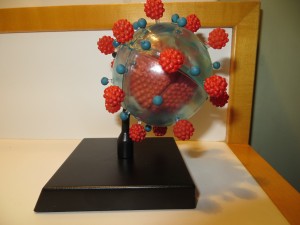
Protein “spikes” on the surface of the influenza virus, called hemagglulutinin and neuraminidase are used by the virus to enter and exit host cells.
The influenza virus is made up of eight segments of RNA, surrounded by a protein coat and an envelope. Two types of protein “spikes” that jut out of the viral envelope are called hemagglutinin and neuraminidase. Hemagglutinin (H) helps the influenza virus attach to host cells, and neuraminidase (N) helps burst the host cell open so the new viral particles can escape. Flu strains are names for these proteins, which is why you see influenza called H1N1, and so on.
These H and N proteins undergo small changes all the time. Each year, health workers and scientists study flu strains around the world by looking at their H and N proteins, among other things. If one of the proteins has changed a little bit, they will give it a new strain name (like H3N2.) Pharmaceutical companies make new vaccines every year so that your body can recognize the new strains with the new H and N proteins to fight them off.
A flu shot primes your body’s immune system to fight the flu virus and get rid of it. How well the vaccine works each year depends on a number of thing, including how well scientists guessed about which strains would be circulating and whether those strains have undergone other changes. How well your vaccine protects you personally depends on variables including what flu strain you’re exposed to, your age, whether you have another viral or bacterial infection at the same time, and even how strongly your individual immune system reacts.
What can you do to minimize your risk of getting sick with the flu? Get your flu shot! Even if it doesn’t work perfectly, it will give your immune system a boost against the virus. The flu is spread by coughing and sneezing and on surfaces like doorknobs and other surfaces. Try to stay away from people who are coughing. Wash your hands frequently and keep them away from your eyes, mouth and nose, which are portals of entry for microbes. Eating right and getting enough sleep will bolster your immune system so that if you do get the flu, you may be able to fight it off faster and better.
Although you can’t grow viral cultures outside a lab, you can make homemade petri dishes to grow fungi and bacteria from your hands. Try a hand-washing experiment where you label four petri dishes #1-#4. Touch plate #1 with unwashed fingers, wash those fingers with water alone and touch plate #2, wash the same fingers with soap and water and touch plate #3, and finally wash one last time with hand sanitizer and touch plate #4. Let the cultures on the plates grow for several days and you’ll see for yourself why it’s so important to wash your hands.
NASA and the American Dream
- by KitchenPantryScientist
A recent trip to Kennedy Space Center made me feel like a kid again and I’m reveling in a momentary lapse of cynicism. Please excuse me if I sound cheesy, or over the top, but I haven’t come back down to earth quite yet.
The United States is is a young nation. We have not been afraid to explore, and our boldness led us to take humankind’s first steps on the moon.
Naturally, our curiosity has led us to some dead ends and we’ve taken a few tumbles, but through basic scientific exploration and hard work we have stumbled upon a wealth of information that has made each of our lives better.
Even while being robbed of our innocence, our country has managed to hold strong to the ideals of freedom and equality. Sadly, our childlike wonder has not been so lucky and is in danger of becoming a casualty of the aging process. Gravity pulls us down each time we cut funding to scientific research. It doesn’t hurt much yet, but could bring us to our knees.
At Kennedy Space Center the last week of April, I attended a “tweetup” sponsored by NASA for 150 of it’s Twitter followers. There to witness the launch of space shuttle Endeavour, we were given behind-the-scenes tours at NASA and listened to a number of astronauts, scientists, engineers, and technicians speak about working for the space program. Their passion and conviction for what they do was the most patriotic expression I’ve ever witnessed. The message I heard over and over again was the mantra of the American dream.
“Work hard in school and you can be whatever you want to be.” (Maybe even an astronaut.)
“The best stuff is still in front of us.”
“When we stop exploring we will falter.”
NASA is not about astronauts sitting around eating freeze-dried ice cream. It is about exploration and science. It is about “revealing the unknown about the planet on which we live” and learning about our place in the universe. The astronauts on the space station are conducting experiments which will yield better vaccines and cancer treatments, among other things. They’re gleaning priceless information about our home planet that we simply can’t capture with our feet on the ground.
Of course it is important for us to be fiscally responsible as a nation, but we can’t lose our childlike wonder or we will lose what sets us apart from the rest of the world. We will fail to thrive when we fail to explore and make new discoveries. NASA embodies the American spirit of exploration and symbolizes what makes us so great as a nation.
As NASA’s chief scientist Waleed Abdalati said, there is a “brilliant future ahead that is ours for the creating.”
Shoreline Restoration
- by KitchenPantryScientist
Fall and spring are great times to plant. The weather is cool and rainy, allowing small sprouts to take root and thrive. If you’re headed up to the cabin this weekend, why not survey your shoreline and think seriously about naturalizing it? It’s easier than it sounds, you’ll love how it looks, and best of all, you’ll be taking a step to make sure your kids and future generations will be able to enjoy the lake in years to come.
Until this summer, my husband’s parents had a grassy, green lawn running from where their cabin stood down to the rocks which had been placed at the water’s edge many years ago. Many of the rocks were slipping into the lake, and the shoreline was beginning to tumble into the water too. Their lake, like many, is susceptible to potentially dangerous blue/green algae blooms, and lawns like theirs contribute to the problem, as fertilizer can flow easily from the lawn into the water.
Last year at the state fair, they spoke with someone who told them they might be able to get a grant through the Atkin County Soil and Water District and the Big Sandy Lakes’ watershed project (originating from the Department of Natural Resources) to help them naturalize their lake shoreline, if they were willing to contribute the labor. They applied and were able to get a grant, work with a landscaper, and replant their shoreline with plants that will slow runoff, reduce erosion, and filter nutrients that can cause algal blooms in the lake. The plantings are filling in after being planted in July, and they look beautiful! Many of the plants have lovely flowers (Lupine, Flox, Columbine) and plants like Swamp Milkweed, which grows close to the water, will be butterfly magnets next summer.
A shoreland buffer strip (also called a filter strip or buffer zone) separates your lawn from the lake. It typically includes taller grasses, blooming plants, shrubs and trees, as well as aquatic plants such as cattails, rushes, and lilies. The work we did involved killing a strip of grass along the lake shore, cutting pieces of wild willow to bind together and stake at the water’s edge, putting natural mesh along the sloped land next to the lake and planting native plants in the prepared area. The dead grass served as mulch and my in-laws had a planting party for friends and other residents of the lake who were interested in learning about what they were doing. I think with 12 people, it took about 3 hours to do all the planting. Not bad for a day’s work.
If that sounds to intense, according to the University of Minnesota’s Shoreland Management Resource Guide, “The easiest approach to establishing a buffer strip is simply to do nothing. If you stop mowing, weeding, and raking your shoreland area, many native plants will likely reestablish.” The link above also lists local nurseries where you can buy native plants and suggests who you can talk to about what to plant on your lake. Or, get in contact with your local lake association to find out whether they have grant money available to help you naturalize your shoreline.
Our cabin still has a mowed green lawn behind the shoreland buffer strip, but we don’t fertilize it and it’s nice to know that someday our grandchildren may swim in cleaner, safer water and catch butterflies in the swamp milkweed by the lake’s edge.
The Mystery of the Dead Sea Scrolls
- by KitchenPantryScientist
This morning, a friend and I headed for the Science Museum of Minnesota to see the “greatest archeological find of the 20th century”, the Dead Sea Scrolls. A Bedouin goat herder stumbled on the first of the ancient scrolls in a cave near the Dead Sea in 1947. Eventually, 10 more caves containing scrolls were discovered near the first cave, and near the ancient ruins of a settlement known as Khirbet Qumran. Later, more scrolls were found in caves around the Dead sea and the Judean Desert. Altogether, more than 900 scrolls were discovered.
The scrolls were often contained in pottery jars, and though many of the scrolls are damaged, it is astonishing that so many of them are in good enough condition to read, or piece together. Two thousand years is a long time for a piece of parchment (animal skin) or papyrus (made from plants) to survive. Scientists attribute the miraculous preservation to the dry conditions in the caves. After all, you need moisture for microbe growth and decomposition.
Using radiocarbon testing, which takes advantage of the fact that all living things incorporate Carbon 14 when they are alive, scientists were able to determine that the scrolls dated from the centuries between 250 BCE and 68 CE. One of the first things I noticed in the exhibit was the use of the term BCE (before common era) and CE (common era), which correspond to B.C. and A.D., but are terms used by scientists.
On the scrolls were mostly words of Hebrew scripture, law and even poetry. Not all of the writing on the scrolls is religious, but the scrolls we viewed were copied from scripts that would one day appear in the Hebrew Bible and included an Apocryphal Psalm, attributed to King Solomon and to David. One scroll we saw was a passage from Genesis and all of the scrolls were copied down before the Hebrew Bible had been set in stone.
What fascinated me most about the exhibit was that the scrolls were copied down during such a tumultuous, pivotal time in the heart of a culture experiencing an uprising of the common people and the birth of Christianity. Archeaologists believe that even as scribes copied the some of the sacred texts onto the scrolls, Jesus was walking through the Holy Land with his disciples. Rome was gaining power in the region, and the Pharisees, representing the common people of Judea, were beginning to rise up against the Priests, or Sadducees, who tended to come from aristocratic families. The Pharisees believed in maintaining an oral tradition so that common people, many of whom could not read, had access to “God’s Word”, while the Sadducees believed in a written tradition, which they interpreted very strictly.
Archeologists and Biblical scholars tell us that Jesus was crucified and Christianity was born as modern Judaism was being shaped, the Judeans rose up against the Romans, and the Temple fell, for the second time, in 70 CE, shattering a way of life for many. Scholars don’t know for sure who hid the scrolls in the caves, or why. It’s a mystery, but there the ancient manuscripts sat, right before my twentieth century eyes, words marching across the page. They stared at me from the Minnesota Science Museum, a world away from where they were penned, a testament to a people who would not be forgotten and a time that changed the world.
Who Will Speak for the Lakes?
- by KitchenPantryScientist
Having grown up in the Flint Hills and tall grass prairie of Kansas, I was in awe when when we moved to Minnesota, with its 10,000 (or 11,842) lakes dotting the landscape. The fact that I now have a lake within walking distance of my house boggles my mind. It’s like a dream to live in a state where you don’t have to be a millionaire to own, or spend the weekend, at a cabin by the water.
I don’t think Minnesotans realize how lucky they are. We take our lakes, and rivers and streams, for granted. Sadly, instead of being stewards of our precious waterways, many property owners build structures that harm our lakes, allowing chemicals and fertilizer to wash into the pristine water every time it rains, interfering with the natural wildlife and vegetation. Not only that, people refuse to replace old septic systems which often cause the lakes where our children swim to be contaminated with human waste. Somehow, we expect our lakes to remain clean and healthy, existing purely for our weekend fun.
Recently, we had a chance to make people take more responsibility for keeping our lakes healthy, so it was depressing to read in last week’s Star Tribune that our governor has once again refused to take measures to care for our local treasures. “It’s like a parting shot out to Minnesota — thumbing his nose at clean water after all these years, which is a dirty legacy to leave,” said Sen. Ellen Anderson, DFL-St. Paul and chair of the Senate environment, energy and natural resources budget committee. In fact, our governor is taking care of his own political aspirations and his friends with environmentally-unfriendly lakeside mansions, while pretending to represent the average Minnesotan.
In the book “The Lorax”, by Dr. Seuss, the Lorax speaks for the trees. Who will speak for our lakes, so that we can continue to enjoy them? Who will speak for the natural resources you enjoy with your family? It’s something to keep in mind come November.
For the next week or so, I’ve decided to blog about water. National Geographic did an amazing job of writing about water and our world in April, and I’m going to participate in P&G’s Give Health “Clean Water Bloggivation”, not to win the trip to Africa, but because they’ll donate clean drinking water to people who need it, in return for participation in the program. I’ll also blog about how you can make your own lake-front more environmentally friendly by planting a strip of native plants and grasses beside the water.
Minnesota Wild
- by KitchenPantryScientist
After spending a weekend relaxing at my parents’ cabin, watching loons, eagles and osprey fishing in the lake, we headed north to Ely and got close up and personal with some much larger Minnesota predators at the North American Bear Center and the International Wolf Center. Our French visitors were especially excited to experience our wildlife, since bears and wolves have been completely eradicated from their own country. They informed us that there was only one bear and a few re-introduced wolves left in France. Fortunately for us, the United States’ depleted wolf and bear populations are coming back thanks to the efforts of organizations like the bear and wolf centers.
At the Bear Center, we watched black bears Ted, Honey and Lucky snack and play from a balcony just above their habitat. We learned that black bears are much less aggressive than grizzly bears and can usually be scared away from campsites by yelling, clapping, and throwing things at them. They are also very unlikely to attack people in defense of cubs, which is a grizzly bear trait. The bears were playful and the 2-year old cub Lucky was especially fun to watch! You can watch these amazing animals live via the “bear cam” on their website at www.bear.org.
Across town, which isn’t very big and is filled with enough canoes and Duluth packs for an army, you’ll find the International Wolf Center. This organization, whose mission is to advance the survival of wolf populations by teaching about wolves, their relationship to wildlands and the human role in their future, has put together an extensive collection of information about wolves in myth and reality (including lots of cool werewolf legend stuff for “Twilight” fans.) Best of all, the facility houses a pack of four wolves living in a viewable habitat behind the facility.
The pack changes over the years, as new wolves are introduced and the pack dynamics change. Two arctic subspecies of the gray wolf, Malik and Shadow, born in 2000, were recently put into “retirement” when they got older and the younger wolves got too aggressive with them. Currently, the pack consists of Grizzer and Maya-two great plains subspecies born May 5, 2004 and Aidan and Denali, two northwestern subspecies, born on April 27, 2008. The wolves weren’t too active when we were there, but at one point, two of them came close to be scratched by some wolf center workers and another took a nap right in front of the viewing window.
The wolves looked like leggy huskies close up and we learned that they have bigger feet (for chasing prey in the snow) and much stronger jaws than domesticated dogs. We also learned that their bodies are made to survive nearly two weeks without food, since they only bring down their prey thirty percent of the time. The wolves at the center are only fed once a week, but you can see them eat if you’re there on the right day. They eat everything except the stomach of their prey, since the stomach contains plants, which they can’t digest.
You can go to www.wolf.org to read more about wolves and watch their wolf pack live on webcams!
We finished the road trip by weaving our way through tall pines and past hidden lakes to the majestic shores of Lake Superior, where we took the scenic highway down the North Shore. Stopping to play on the rocks and hike down to the lake at Gooseberry Falls State Park was a highlight of the trip, even as rain started to fall. My husband looked like a kid again as he waded smiling into the frigid water of Lake Superior and stomped around in the waves. I felt thankful to live in Minnesota and for all the efforts people have made to preserve our wilderness and nurture our native species.
Beware the Pretty Birds!
- by KitchenPantryScientist
We spent last week in Iowa at a family reunion at lake Okoboji, a deep, clear, gorgeous lake near the Minnesota border. My great grandparents had a cottage there, and every year my mom’s side of the family returns to spend a week swimming, fishing, going to the lakeside amusement park and just hanging out.
Gull Point is a pretty piece of land with a sandy beach and sandbar that juts out into the lake and is one of our favorite destinations. Each year we spend an afternoon or two there, swimming, skipping rocks and digging our toes into the sand. We didn’t see many gulls this year, but there was a pretty white pelican hanging out nearby. Little did I know that water birds carry a tiny parasite that infects snails in the water. The parasite’s larvae are then released and swim around looking for a suitable mammalian host to burrow into and continue their life cycle.
Ignorant of the tiny bugs digging into our skin, we frolicked in the water for hours.
Humans are not a good host for these parasites and they soon die, leaving their buggy corpses under our skin. Some people don’t have much of a reaction, but others have immunes systems that kick into high gear, rejecting the dead parasites with an inflammatory response in the the form of big, itchy, awful bumps.
My son is definitely allergic. The CDC website has more information on Swimmer’s Itch, or Cercarial Dermatitis, which can also be found in many Minnesota lakes. Generally, it doesn’t need much treatment except Hydrocortisone cream or Calamine lotion. My daughter and I have a few itchy bumps, but nothing major. My son, on the other hand is on oral prednisone too calm his allergic reaction. Needless to say, it has been a long, long week.
According to the University of Minnesota’s Extension Service, you can do the following things to reduce your chances of getting severe swimmer’s itch:
- Dry off as soon as you leave the water. Rub skin briskly to remove water drops before they evaporate. Be sure to dry underneath waistbands and around leg openings. Encourage children to dry off thoroughly each time they leave the water.
- Shower with soap and fresh water or change into dry clothes as soon as possible.
- Don’t wade or play in shallow water. Swimming from a raft or pontoon minimizes your exposure.
- Don’t feed geese and ducks near your beach. Waterfowl are an important adult host for the parasites.
You can also go to http://checkmylake.com to search for specific lakes to see if they’re safe for your family to swim in. I wish I would have checked!
Father’s Day at the Science Museum
- by KitchenPantryScientist
I just got this email from the Science Museum of Minnesota and thought I’d share it with you. It sounds like a great way to spend Father’s Day!
Father’s Day – Sunday, June 20, 2010 – 12 p.m. to 5 p.m.
at the Science Museum of Minnesota
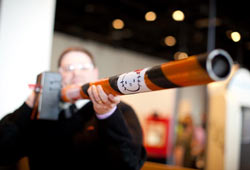 Make: Day at the Science Museum is this Father’s Day—Sunday, June 20, 2010. Mark your calendars for the chance to meet with an astounding group of local engineers, artists, tinkerers, and inventors. They’ve been hard at work, and now they want to share their DIY creations with you.
Make: Day at the Science Museum is this Father’s Day—Sunday, June 20, 2010. Mark your calendars for the chance to meet with an astounding group of local engineers, artists, tinkerers, and inventors. They’ve been hard at work, and now they want to share their DIY creations with you.
Presentations to see, hear, and interact with include:
- A 3D Printer that makes plastic models from computer designs right before your eyes
- A potential Guinness World Record-breaking attempt using kinetic gadgets
- Musical performances by experimental musicians using custom-built instruments
- A bicycle ride across a suspended cable
- Plus a whole lot more!
You’ll have the opportunity to meet with the makers, ask them about their inventions, and learn about ways that you can get involved with local making communities. Presentations will be located throughout the museum’s exhibit galleries. The event is included with regular museum admission.
Dads get in free to Make: Day!
Make: Day is a great way to celebrate Father’s Day with the whole family. With all the amazing DIY presentations, there’s sure to be something for everyone. And don’t forget to take advantage of the incredible opportunity for dads to get in free with the Make: Day Father’s Day coupon. Just print it out and present it at the box office along with any full-price ticket purchase. The free admission is good for any exhibit combination, including the Omnitheater and The Dead Sea Scrolls. So bring your DIY (or not-so-DIY) dad down and see what’s being made!
